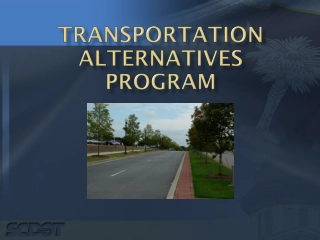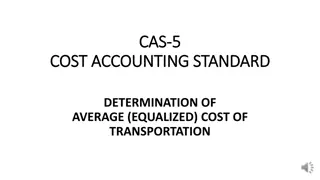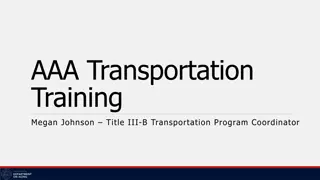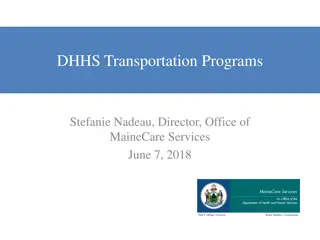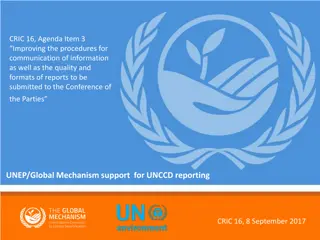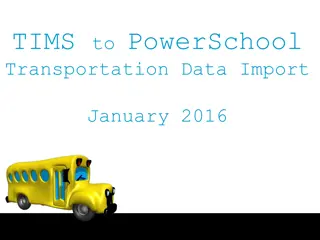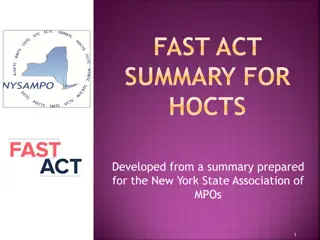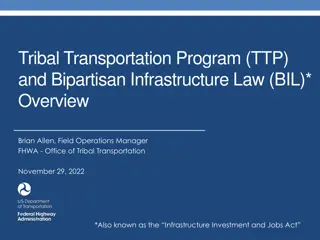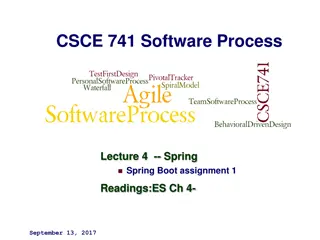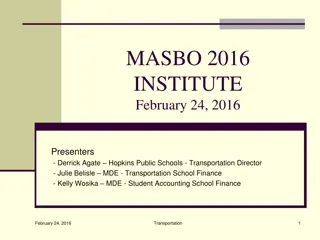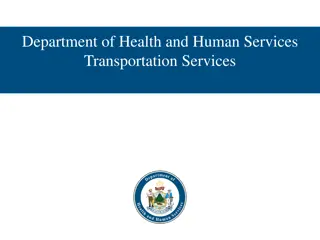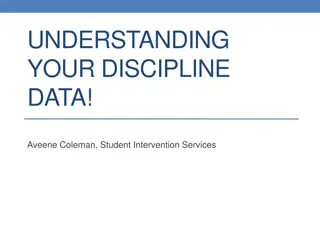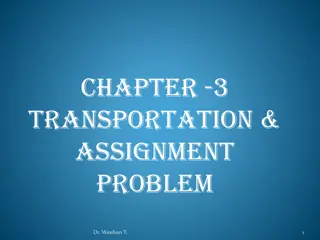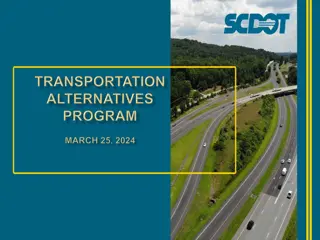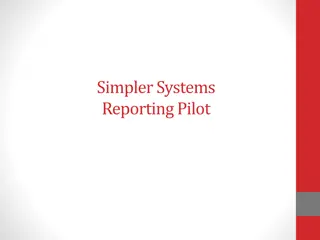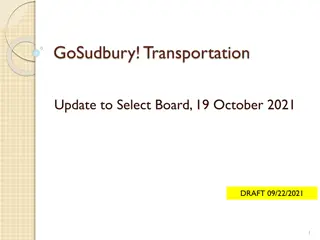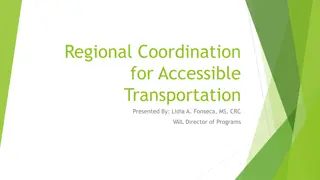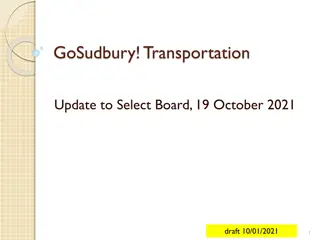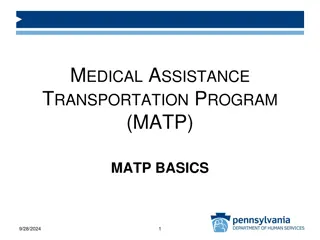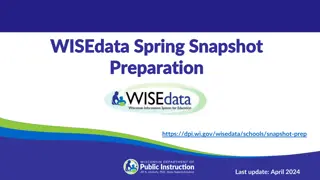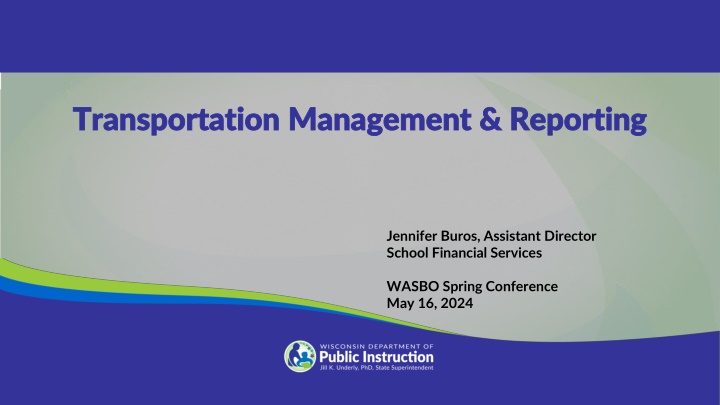
Advanced Pupil Transportation Management and Aid Programs
Explore various sources of pupil transportation aid, including specialized transportation for students with IEPs, distance-based aid programs, and documentation requirements for reliable reporting. Learn about Fund 10 pupil transportation aid programs for both regular and summer sessions, detailing transportation provided for public and private school students. Dive into the crucial aspects of managing and reporting pupil transportation efficiently.
Uploaded on | 0 Views
Download Presentation

Please find below an Image/Link to download the presentation.
The content on the website is provided AS IS for your information and personal use only. It may not be sold, licensed, or shared on other websites without obtaining consent from the author. If you encounter any issues during the download, it is possible that the publisher has removed the file from their server.
You are allowed to download the files provided on this website for personal or commercial use, subject to the condition that they are used lawfully. All files are the property of their respective owners.
The content on the website is provided AS IS for your information and personal use only. It may not be sold, licensed, or shared on other websites without obtaining consent from the author.
E N D
Presentation Transcript
Transportation Management & Reporting Transportation Management & Reporting Jennifer Buros, Assistant Director School Financial Services WASBO Spring Conference May 16, 2024
Sources of Pupil Transportation Aid Sources of Pupil Transportation Aid Students provided specialized transportation as required by the individual student s IEP (Fund 27) Based on the qualifying costs reported Students qualifying to receive pupil transportation and actual participation in one of the (Fund 10) programs Based on distance from pupil s residence to school of attendance following the shortest commonly traveled route
Fund 10 Pupil Transportation Aid programs Fund 10 Pupil Transportation Aid programs PI-1547-SS public and private school students transported to attend summer sessions and/or interim sessions Starts the school year, due by September 30th of current year Report transportation provided for summer session that starts after the previous school year ends and before the current school year begins Includes interim sessions from the previous school year. Based on one category (distance); whether the student is transported either 2 5 miles or over 5 miles Part of the transportation audit process
Fund 10 Pupil Transportation Aid programs Fund 10 Pupil Transportation Aid programs PI-1547 public and private school students transported during the regular school year by school districts and charter schools Report opened May 15 and is due June 28 Five distance categories Only districts that have a DPI approved Unusually Hazardous Transportation (UHT) plan can enter riders in the Less Than 2 Miles (hazardous area) category Per Board policy, a district may transport and include Open Enrolled In students from the district border to school of attendance District can also include students transported based on a contract with a parent or service provider
Fund 10 Pupil Transportation Aid programs Fund 10 Pupil Transportation Aid programs PI-1547 public and private school students transported during the regular school year by school districts and charter schools Districts are responsible to provide reliable documentation and NOT undocumented assumptions or estimates to support the number of pupils reported as actually transported at least once during the school year. A signed and dated document listing students who rode each bus during the school year by bus driver is great! The qualifying distance the student was transported can come from the transportation director/contractor. $24,000,000 is distributed based on the PI-1547-SS and PI- 1547 data from the previous school year in January and June
Fund 10 Pupil Transportation Aid programs Fund 10 Pupil Transportation Aid programs High Cost Pupil Transportation Aid is a separately funded program. Paid in June, for the previous school year, based on audited information. Example: FY23 will be paid in June of 2024. This aid program provides additional funding to school districts that have higher per pupil transportation costs when compared to the statewide average per pupil transportation cost To qualify the district s Fund 10 cost/student must exceed 140% of state average/student cost and have 50 students/square mile or less Allocation = $22,800,000
PI PI- -1547 1547- -SS summer/interim reporting SS summer/interim reporting Distance in Miles Distance in Miles Summer/Interim (PI Summer/Interim (PI- -1547SS) 1547SS) Less Than 2 miles (hazardous area) Over 2-5 miles NA $10/pupil Over 5 up to 8 miles $20/pupil Over 8 up to 12 miles $20/pupil Over 12 miles $20/pupil Increased and only one factor to be considered for summer school interim: distance from student s residence to school (attendance). Districts are not required to transport for summer/interim sessions to the same standard as during the regular school year.
PI PI- -1547 regular year reporting 1547 regular year reporting Distance in Miles Distance in Miles Regular Year (PI Regular Year (PI- -1547) 1547) Less Than 2 miles (hazardous area) Over 2-5 miles $15/pupil $35/pupil Over 5 up to 8 miles $55/pupil Over 8 up to 12 miles $110/pupil Over 12 miles $400/pupil* The Less Than 2 Miles (Hazardous Area) category requires DPI approval before data can be entered. *Reimbursement rate for the Over 12 miles category was raised per 2023 Act 19 (2023-25 biennial budget).
Pupil Transportation Aid Payments Pupil Transportation Aid Payments As outlined earlier, Pupil Transportation Aid is determined by the number of students, attending both public and private schools, who are transported from residence to school of attendance at least once. When the district transports fewer students, under current law and related rules, their regular pupil transportation aid will be less in their January payment the following school year. After the January aid payment, the remainder of the funds (minus the transporting on ice aid - Bayfield) are paid out in June based on the District s percentage of state pupil transportation aid in January.
Route Planning Tips Route Planning Tips Regular meetings early and throughout the year with transportation department and/or bus company Review procedures with staff annually Verify student addresses Familiarize yourself with the bus routes and new students
How to report a student How to report a student Transported to daycare location?If the most direct route to the daycare location is greater than the most direct route to the student s residence, the district must make the mileage category determination based on the student s residence location. Who moved during the school year?A student who is transported at least once will be counted in the mileage category as determined by the LEA on the PI-1547. The determination of the mileage category does not need to be modified for the given school year as long as the student continues residing in the school district. Being transported by a third party/parent? If the district is paying for this service, the student will be counted in mileage category that reflects the most direct route from residency to school of attendance. This payment is calculated from a contract with the provider at a daily rate.
Transporting Private School students Transporting Private School students Q/A # 3. Must a public school district provide transportation to private school pupils on days the public school is not in session? An opinion from the Attorney General, 61 O.A.G. 240, 244 (1972), stated that a public school board is required to provide transportation for private school pupils attending school on days when the public school district is not in session. The Wisconsin Court of Appeals confirmed that position in Hahner v. Board of Education, Wisconsin Rapids, 89 Wis. 2d 180 (1979). It is beneficial to both the public and private school(s) in the same school district to have school calendars which are as consistent as possible. https://dpi.wi.gov/parental-education- options/transportation/private-school-questions Also see Transportation to Private Schools General Information https://dpi.wi.gov/sfs/support/school-operations/pupil- transportation/private webpage.
Observed Patterns of Support Observed Patterns of Support Provide training for new employees and develop a District Year-at-a-Glance; Institute a review process. Meet with your transportation vendor or employees on a regular basis including before student counts. While one pupil count is required per year, additional counts will provide documentation and probably increased ridership numbers. Complete counts ahead of time; institute a double-check process; predict what is different this year and plan how to address it.
State & IDEA Eligible Transportation State & IDEA Eligible Transportation For those students whose IEPs specify transportation needs, For those students whose IEPs specify transportation needs, a district may provide specialized transportation and have a district may provide specialized transportation and have those costs included in their overall costs eligible for Special those costs included in their overall costs eligible for Special Education and School Education and School- -Age Parents Aid. Age Parents Aid. When required by IEP When required by IEP Eligible route must be 100% IEP Eligible route must be 100% IEP- -required exceptions. exceptions. required with limited with limited
State & IDEA Eligible Transportation State & IDEA Eligible Transportation Limited Exceptions: Limited Exceptions: Incidental Benefit Exception: picked up at same location; no additional costs; doesn t displace rider with IEP Newly Homeless Accommodation or Foster Care: up to 20 days
State & IDEA Eligible Transportation State & IDEA Eligible Transportation Additional service on regular route (to and from school) Additional service on regular route (to and from school) e.g. bus aide for one student per their IEP Only the excess cost of the service is eligible (Fund 27) Regular route transportation (Fund 10) A student maybe be eligible for special education A student maybe be eligible for special education categorical aid for support services while being transported categorical aid for support services while being transported on the regular bus route and be eligible for Pupil on the regular bus route and be eligible for Pupil Transportation Aid Transportation Aid
State & IDEA Eligible Transportation State & IDEA Eligible Transportation A student who exclusively rides a specialized A student who exclusively rides a specialized transportation route transportation route may not may not be counted for Pupil Transportation Aid. Transportation Aid. be counted for Pupil
State & IDEA Eligible Transportation State & IDEA Eligible Transportation The following are some transportation scenarios The following are some transportation scenarios a district may encounter. a district may encounter.
State & IDEA Eligible Transportation State & IDEA Eligible Transportation Example: A district operates a route that transports Example: A district operates a route that transports several students with IEPs that require specialized several students with IEPs that require specialized transportation as well as a few other students who live transportation as well as a few other students who live along the route. along the route. Is this route eligible for state Special Education Aid? Is this route eligible for state Special Education Aid?
State & IDEA Eligible Transportation State & IDEA Eligible Transportation No: A route that serves students with and without IEPs is No: A route that serves students with and without IEPs is not eligible for state Special Education Aid. The district not eligible for state Special Education Aid. The district should report the number of students transported on the should report the number of students transported on the route on its PI route on its PI- -1547 Pupil Transportation Report, including 1547 Pupil Transportation Report, including the students with IEPs. The entire cost of the route is the students with IEPs. The entire cost of the route is coded to Fund 10. coded to Fund 10.
State & IDEA Eligible Transportation State & IDEA Eligible Transportation Example: A district owns a bus that has a wheelchair Example: A district owns a bus that has a wheelchair lift. This vehicle is used on a route that includes lift. This vehicle is used on a route that includes students without IEPs as well as one student with an students without IEPs as well as one student with an IEP who uses a wheelchair. IEP who uses a wheelchair. Is this route eligible for state Special Education Aid? Is this route eligible for state Special Education Aid?
State & IDEA Eligible Transportation State & IDEA Eligible Transportation No: No: The presence of a wheelchair lift does not in and The presence of a wheelchair lift does not in and of itself make the route eligible for state Special of itself make the route eligible for state Special Education Aid. The district should report the Education Aid. The district should report the number of students transported on the route on its number of students transported on the route on its PI PI- -1547 Pupil Transportation Report, including the 1547 Pupil Transportation Report, including the student with the IEP. The entire cost of the route is student with the IEP. The entire cost of the route is coded to Fund 10. coded to Fund 10.
State & IDEA Eligible Transportation State & IDEA Eligible Transportation Example: A special education student with transportation Example: A special education student with transportation identified in the student s IEP received specialized identified in the student s IEP received specialized transportation at the beginning of the year, but during the year transportation at the beginning of the year, but during the year no longer needed that support and is switched to a regular bus no longer needed that support and is switched to a regular bus route. Is the cost for transporting the student eligible for route. Is the cost for transporting the student eligible for special education aid for specialized transportation AND special education aid for specialized transportation AND eligible for regular pupil transportation aid for the regular bus eligible for regular pupil transportation aid for the regular bus route even though both took place in the same year? route even though both took place in the same year?
State & IDEA Eligible Transportation State & IDEA Eligible Transportation Yes: In this example the student is eligible for special Yes: In this example the student is eligible for special education aid for specialized transportation and eligible for education aid for specialized transportation and eligible for regular pupil transportation aid because the student regular pupil transportation aid because the student changed from specialized transportation to regular changed from specialized transportation to regular transportation based on IEP changes. However, a student transportation based on IEP changes. However, a student exclusively receiving special or additional transportation all exclusively receiving special or additional transportation all year could year could not not also be counted for regular transportation also be counted for regular transportation aid. aid.
State & IDEA Eligible Transportation State & IDEA Eligible Transportation SPED vehicle/equipment purchases w/ pre SPED vehicle/equipment purchases w/ pre- -approval approval No approval needed for equipment <$10,000 Follow instructions on our website Vehicle Purchase - Categorical Aid Request
State & IDEA Eligible Transportation State & IDEA Eligible Transportation Additional Resources Additional Resources Special Education Transportation Specialized Transportation Aid Eligibility and Funding
Large Van Regulation Large Van Regulation Wisconsin DOT School Bus Definition Wisconsin DOT School Bus Definition motor vehicle which carries 10 or more passengers for the purposes of transporting students to or from school, curricular, or extracurricular activities. Wisconsin State Statute Wisconsin State Statute 121.555 121.555 Defines alternative methods of transportation Limits vehicle size to 9 passengers or less
Issues with Large Vans Issues with Large Vans Higher Center of Gravity Higher Center of Gravity Adding passengers and cargo moves the center of gravity higher and toward the rear of the vehicle o Causes instability and the potential for drivers to lose control during emergency handling maneuvers Flat sides contribute to instability in crosswinds Flat sides contribute to instability in crosswinds o Structural rigidity that was designed for the less Structural rigidity that was designed for the less demanding rigors of transporting cargo demanding rigors of transporting cargo
Issues with Large Vans Issues with Large Vans Underinflated Tires Underinflated Tires NHTSA Study 75% 15-passenger vans had improperly inflated tires Improperly inflated tires changes handling characteristics Increases potential for a rollover crash
Safety Recommendations for 10 Safety Recommendations for 10- -Passenger Vans Passenger Vans Make sure the vehicle is properly maintained Make sure the vehicle is properly maintained Properly inflated tires are critical Properly inflated tires are critical Check tire pressure and wear prior to each trip Large vans handle differently Large vans handle differently Use drivers familiar with handling issues Keep the load light Keep the load light Do not overload the vehicle with students and athletic equipment Overloading the vehicle increases rollover tendency
Transporting Students in Alternative Vehicles Transporting Students in Alternative Vehicles School board must ensure compliance with Wis. Stat. 121.555: (1) A school board or the governing body of a private school may provide pupil transportation services by the following alternative methods: (a)A motor vehicle transporting 9 or less passengers in addition to the operator. (b)A motor vehicle transporting 10 or more passengers in addition to the operator and used temporarily to provide transportation for purposes specified under s. 340.01 (56) (a) when the school board or the governing body requests the secretary of transportation to determine that an emergency exists because no regular transportation is available. The secretary of transportation shall approve or deny the request in writing. Any authorization granted under this paragraph shall specify the purpose and need for the emergency transportation service.
Transporting Students in Alternative Vehicles Transporting Students in Alternative Vehicles School board must ensure compliance with Wis. Stat. 121.555, and may consider including in contract the following: Required insurance coverage limits Annual inspection comply with DOT rules and requirements of Wis. Stat. 110.075 Operator Requirements o Valid WI driver s license o 18 years of age o Sufficient use of hands/feet to operate brake and accelerator - may be waivable o Medical opinion every 3 years stating no mental or physical disability impacting ability to operate motor vehicle can use examination report used for school staff Limited to transporting the number of passengers that can be seated on permanently mounted seats facing forward without interfering with operator
Tips for a Successful Audit Tips for a Successful Audit Stay current on new laws, especially during the development of the bi-annual state budget. Pre-audit conversation with auditors about areas of emphasis; model what is expected with employees. Create checks and balances. Complete counts on a timely basis. Maintain documentation. Call us for assistance.
Thank You! Thank You! Jennifer Buros, Assistant Director School Financial Services Team 608-266-1966 jennifer.buros@dpi.wi.gov Visit our website: http://dpi.wi.gov/sfs

